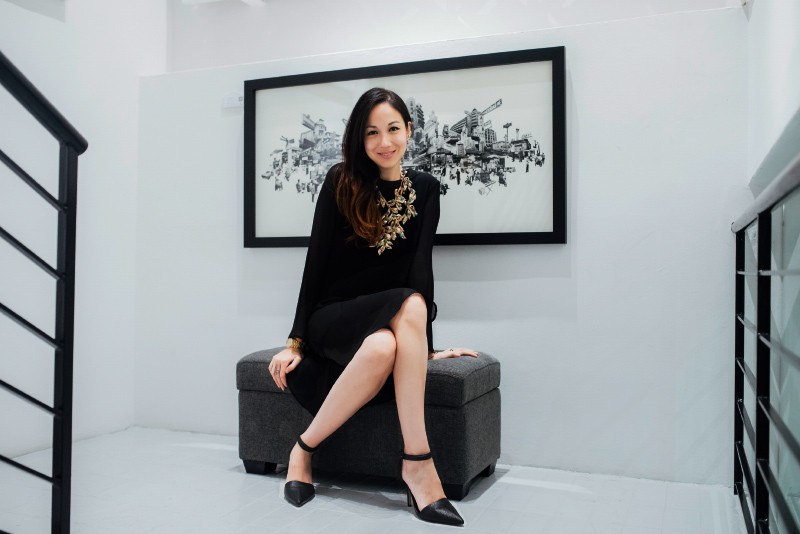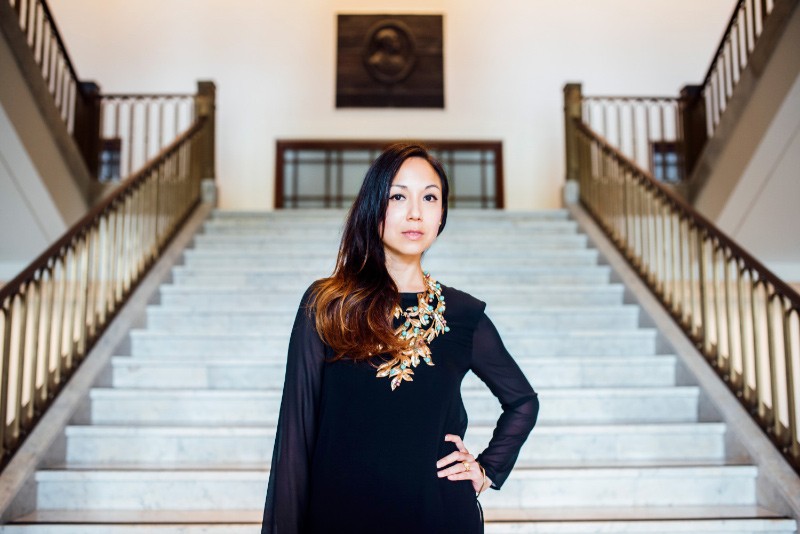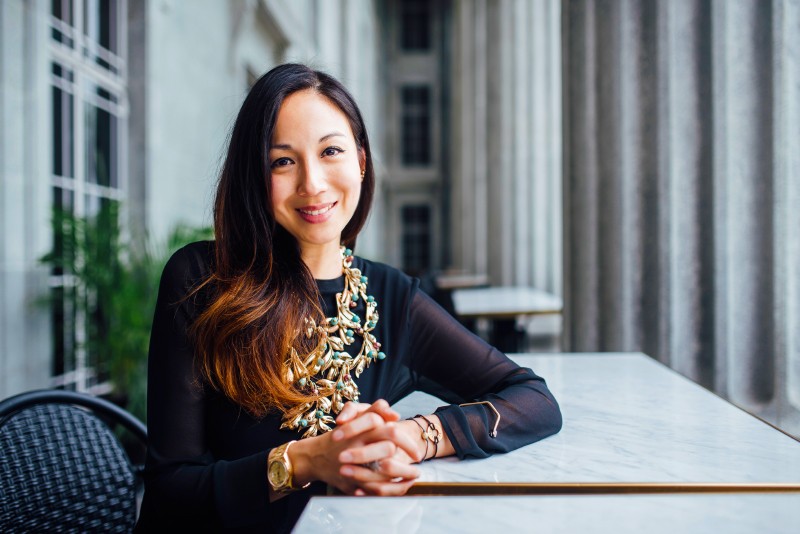Talenia Phua Gajardo: Total Passion for the Total Height

As Talenia Phua Gajardo tears away from her work to greet me, I am struck by how pristine she looks—her face betrays none of the dishevelment and weariness that typically accompany life in a start-up. She wears a pair of vertiginous heels that make her tower over 6ft, accentuating her tall, lithe figure, while her simple black dress accessorised by a statement necklace lends a touch of sophistication to her outfit. Her preference for a minimalist design distinguished by detailing is also apparent in the clean, user-friendly layout of her websites. “The look and feel of the website are crucial in getting people to stay and browse through our art offerings, because unlike in a physical gallery where we may linger and ponder, our online attention span is much shorter,” she says, emphasising the importance of aesthetics in e-commerce. Talenia’s motivation for embarking on an entrepreneurial journey is reminiscent of what Drew Houston, co-founder of Dropbox, once said of the happiest and most successful people he knew: “[They] don’t just love what they do, they’re obsessed with solving an important problem, something that matters to them.” And her obsession boils down to the lack of representation for Southeast Asian artists. She is clearly spirited about raising the visibility of artists in the region, and helping them reach a wider audience. “Collectors from other parts of the world are unlikely to fly in for gallery openings to view these works in person,” she remarks while gesturing toward a painting by Singaporean artist Genevieve Chua that hangs in her office. “My goal is to create a platform that allows Southeast Asian artists to reach those new markets.” Speaking admiringly of American sculptor Richard Serra, who is known for making large-scale works with metal sheets, Talenia reveals her fascination with monumental artworks. As she gushes about feeling engulfed by the stupendousness of his art, I can imagine her standing at the foot of the 67ft Vortex, stupefied by its sheer immensity. Her desire to be dwarfed and awestruck suggest a contentment in being swept up in the moment, in the romance, and in the beauty. As we begin photographing her, the image of Talenia being a passive observer changes—now, she is the centre of attention. And this sudden spotlight makes her slightly uncomfortable. “I prefer to be behind the camera,” she says in an almost defiant tone. Her reluctance in yielding creative control shows a commanding nature that is equally alluring as the way she looks.
MELPOMENE HUA: What was your most important takeaway during your time at Zaha Hadid?
TALENIA PHUA GAJARDO: You can make anything. In the 80s, Zaha Hadid was designing buildings that we couldn’t even build. For example, double curvature was really difficult to achieve then, but with advances in technology, it is now possible. Understanding that there are no limitations to what you can build really changed my perspective.
MELPOMENE: People always say that your first job defines you.
TALENIA: It’s true. Being able to witness and experience the level of devotion to the craft really stuck with me. To achieve anything at all you have to work hard and be aggressive, but also be collaborative at the same time. One of the most interesting aspects at Zaha Hadid was the collaboration across industries—we worked with jewellery designers, fashion designers, and even people in the aerospace industry. We also sought advice from different industries because the geometries we wanted to achieve were so complex.
MELPOMENE: What is the purpose of architecture?
TALENIA: The general purpose is to provide shelter, but the specific purpose depends on the client. Some projects we worked on at Zaha Hadid were of a phenomenal scale that is unlikely to work elsewhere, such as the King Abdullah Petroleum Studies and Research Center. Some civic projects, such as the Guangzhou Opera House, are meant to change people’s perception of a place.
MELPOMENE: Does form follow function then?
TALENIA: Each project is unique, and sometimes one drives the other. If you’re designing an art museum, there will most likely be a very strong emphasis on form. For example, the Louis Vuitton Foundation in Paris has a visually striking façade that isn’t intended to be functional. On the other hand, if you’re designing an office building, the most important factor is how many people you can fit into the space, and thus, gross floor area may take priority. The Gateway (Singapore) designed by I.M. Pei is stunning, but the sharp corners needed to achieve that visual effect is unusable. Ultimately it should be a balance—aesthetically pleasing but still functional.
Ultimately you’re creating art for it to be consumed.
MELPOMENE: What do you think of HDBs?
TALENIA: That’s pure function, the only form is colour differentiation. Everything is pre-fabricated en masse, brought on-site and stacked, because that’s the most cost-efficient approach. But that said, SCDA Architects recently designed the most beautiful five-block HDB estate, and Chan Soo Khian did an amazing job of changing the standard typology with SkyTerrace@Dawson. It looks nothing like the typical HDBs.
MELPOMENE: What is an architecture-related book that you identify with?
TALENIA: The Fountainhead. I identify with Ayn Rand’s strong brand of individualism and her message of staying true to one’s vision. There is an ever-present demand for architects to change their designs and in practice the extent to which an architect can hold their ground is directly related to how established they are in the industry. The more work you have under your belt, the more clients are able to trust you, and consequently the more creative freedom you’ll have.
MELPOMENE: Do artists have more creative freedom than architects and designers?
TALENIA: Artists go through a similar process. There is a lot of pressure to keep producing works that sell well. A lot of artists have a whole body of work that they want to make but may not be commercially viable, and they’re faced with the exact same question: How much do you alter your work to suit the market? For example, Damien Hirst had an entire series of work that just didn’t sell as well as his more digestible dots or butterflies. It’s a general dilemma of being in creative industries because ultimately you’re creating art for it to be consumed.
Sometimes art can express things that words can’t.
MELPOMENE: What does art mean to you?
TALENIA: This is a really difficult one. [laughs] You can’t define it, but I’d say it’s the creativity and expression of an individual; feeling embodied by an object or represented on a canvas. Sometimes art can express things that words can’t.
MELPOMENE: Why did you start The Artling?
TALENIA: Through some of my interior design and architectural work, I started sourcing art for clients, and felt that there wasn’t really a representation of Southeast Asian contemporary art. Collectors from Australia or the U.S. are unlikely to be present physically for a gallery opening in Southeast Asia, and the only way is to view the artworks online. So, I started The Artling to allow contemporary Southeast Asian artists to reach new markets.
MELPOMENE: Do people interact with art differently when it is showcased online instead of in a physical gallery?
TALENIA: For sure. And we’re not looking to replace the physical experience, but to provide an additional avenue. The online and physical galleries complement each other. People bought art online before the introduction of online galleries, via email. What makes them buy online is their trust in the brand, and that is why the galleries we partner with are important in lending credibility to the site.
MELPOMENE: Is art accessible?
TALENIA: Most definitely, it doesn’t matter if you start with a $300 or $30,000 budget, there’s always something for everyone. Herbert and Dorothy Vogel, a postal clerk and a librarian in New York City, were not rich but they always set aside a small amount of money to collect art they liked and ended up with an amazing modern art collection. That shows you really don’t need a huge amount of money to start. On the entry level, it’s more like education, you just have to be interested in learning about the artists and their work.
The journey of collecting art is also a journey of self-discovery.
MELPOMENE: Do you need an aesthetic sense to collect art?
TALENIA: No, because it’s very personal. It’s important for people to be able to find something that reflects their personality because your art collection is essentially a reflection of yourself. It can be overwhelming if you’re just getting into it, and in the beginning, people often don’t know what they like. But gradually, they start to train their eye and also learn about themselves—some are more affected by colour, while others prefer three-dimensional art… the journey of collecting art is also a journey of self-discovery.
MELPOMENE: What are the criteria you use to judge art?
TALENIA: It has to be visually intuitive. Humans are very visual creatures and your immediate reaction to a piece is always going to be emotional. The understanding probably comes later, if at all. The narrative around the work is really important, and if you don’t make the effort to read about the artist, it’s unlikely that you’ll be able to understand his or her work.
MELPOMENE: Is there a particular style or form that appeals to you?
TALENIA: I really like three-dimensional art—some of my favourite works are by sculptors like Richard Serra and John Chamberlain. I find a lot of American artists interesting partly because they are able to work in scales, which we can’t really do here. I’m very fascinated by the idea of scale, and the feeling of being engulfed by monumental pieces. Here the size of our artwork is constrained by the space we have.
MELPOMENE: What do you think about the art scene in Singapore?
TALENIA: People always like to compare us to Hong Kong but that is not an entirely fair comparison. The collector pool in Hong Kong is larger because of the Chinese collectors, and there is no tax on art. Singapore is still young, and it’ll just take time and more education to get people interested in art. We are already starting to see many first-time home owners wanting to buy art for their spaces.
MELPOMENE: Global art sales were down almost 10% last year. Does that worry you?
TALENIA: Not at all, art is cyclical. The art market is relatively insulated from the financial markets, as evidenced by records in auction prices in the midst of the 2008 financial crisis. This year is particularly bad because there’s a lot of uncertainty globally, which affects retail sentiments but things will come around, as they always do. Interestingly, with stocks and real estate showing an increase in volatility, people are starting to bet on big names in art because they think that they can hold their wealth better in such investments.
MELPOMENE: Why did you start Luxglove?
TALENIA: Through The Artling, we received requests from individuals who were looking to sell pieces from their collection. In art, there’s the primary market where pieces come directly from the artists or galleries, and the secondary market where the pieces are pre-owned. Selling preowned art through galleries is sometimes problematic because auctions are cyclical and galleries don’t take in many pieces. We discovered there was a really big demand for an alternative solution, and started Luxglove to meet that demand. Besides art, we also sell vintage collectables, jewellery, and whisky.
MELPOMENE: Is there a demand for vintage?
TALENIA. Definitely. In fact, we just sold our $85,000 Yamazaki Whisky. As people become more sophisticated, they seek out things that are unique. Our generation of collectors is also a lot more receptive to vintage because they’re not hung up on the idea of something being “preloved”. For example, vintage Rolexes have really taken off. In the past, people might have been put off by the fact that they are “used”, but now people recognise that these preowned pieces have their own stories.
MELPOMENE: What do you write or draw in your daily notebook?
TALENIA: Everything. It’s where I write my to-do list, and I found it to be far more effective than Google Calendar. I have a page for ideas, sometimes I’ll get one in the middle of the night and I’ll put it in there. I use it for sketches as well—I get really restless when I’m on the phone so I’ll always be drawing… I probably have a whole stack of phone drawings by now [laughs].
MELPOMENE: Finally, do you consider yourself to be an aggressive person?
TALENIA: I am definitely more aggressive than the average person, but sometimes people confuse independence with aggressiveness. I have been told by some that I’m too independent because I’m extremely persistent in executing my ideas. I’m stubborn that way, and if you have a goal that you truly want to achieve, there is very little room for compromise.
****
Edited by Wy-Lene Yap




